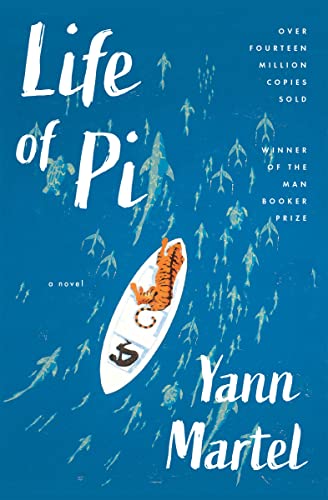Alright, folks, buckle up! You’re about to read my honest and sometimes silly review of the wildest book I’ve read this year—no, not a cookbook. It’s Life of Pi. This review will break down why Pi’s story had me glued to my seat, laughing, scratching my head, and rethinking snacks on boat trips. I’ll look at Pi’s knack for surviving a rough patch (okay, the roughest patch), his wild imagination, his confusing faith buffet, and what those animals might really mean. Hold onto your hats—and maybe your lifeboat—because we’re about to talk tigers, faith, and a whole lot of fishy business. Let’s go!
Life of Pi: A Wild Tale of Survival and Wonder
In a nutsheel
Life of Pi is a magical adventure and survival novel by Yann Martel. It’s part coming-of-age, part spiritual quest, and part, “My vacation was worse than yours.”
The story stars Piscine Molitor Patel (thank goodness everyone calls him Pi), a boy from India who loves animals and has a rather, let’s say, enthusiastic relationship with religion. After a shipwreck, Pi finds himself stranded on a lifeboat in the vast Pacific with some very unique company, including a tiger who is less Tony the Tiger and more “please don’t eat me.”
This book is a wild mix of adventure, philosophy, and humor. Themes of faith, survival, and questioning reality float around like, well, a hungry tiger on a boat. If you like books that make you think, laugh, and maybe question your own sanity, this one’s for you.
Mastering Survival and Human Resilience Through ‘Life of Pi’
Let me tell you, if I ever get stuck on a lifeboat with a tiger, I’d probably faint faster than you can say “Richard Parker.” But Pi, the hero of Life of Pi, pulls off survival with more style than I do finding matching socks.
Pi’s struggle is more than just fighting hunger and thirst. The kid deals with fear, loneliness, and the kind of boredom that makes you talk to your toenails. He teaches us that survival isn’t just about eating raw fish or drinking rainwater (though both help!). It’s about keeping hope alive, even when you’re half convinced your new tiger roommate wants you for lunch.
What I love about Life of Pi is that it shows how people can do wild things when life throws them off the deep end. Pi doesn’t just survive—he finds ways to laugh, pray, and even take swimming lessons (with a tiger as a lifeguard, no less). The book made me think, “Hey, maybe I could handle a week without Wi-Fi!” Well, almost.
Of course, it’s not all fun and games. Pi’s journey gets dark, and he questions if it’s even worth surviving some days. But that honest struggle makes his resilience shine brighter. I finished the book feeling both exhausted and inspired, which is pretty much how I feel after eating my mom’s lasagna.
Feeling tough yet? Hold onto your orange life vests—we’re about to step into a world where what’s real gets fuzzy: next up, ‘Imagination versus Reality’. It’s going to get trippy!
Imagination Versus Reality: The Blurry Lines in Life of Pi
Let’s talk about something really weird: what’s actually real in Life of Pi? I finished the book and thought, “Wait, did any of this actually happen?” The story is like when you wake up from a dream and can’t tell if it was all in your head or if your cat really did know how to talk. Author Yann Martel piles up the oddest events you can think of—zebras on lifeboats, carnivorous islands, and a tiger named Richard Parker who, frankly, would never win ‘pet of the year.’
The biggest mind-bender for me (and for my friend Dave, who I read it with during our book club—he actually lost sleep over this) was the two different versions of Pi’s tale. One has all the animals, the other is much darker, with humans taking their places. It’s like a choose-your-own-adventure, but both endings leave you scratching your head. Yann Martel keeps messing with you until you start wondering if your own goldfish has a secret name.
I really liked how the book makes you ask, “What would I believe?” Do you prefer the wild story with the tiger or the brutal, sad version? It’s kind of like picking between watching a cartoon or the news—both tell stories, but which one makes you feel better? I think Pi’s imagination kept him going, but Martel never tells you what to believe. That’s clever, even if it frustrated me harder than a missing sock.
If you’re ready to chase even more mysteries, next we’re digging into the spiritual jungle of Pi’s faith—hold onto your hats and your holy books!
Spirituality and Faith: Pi’s Inner Lifeboat
Let’s talk about faith, because Life of Pi handles the subject like your aunt at Thanksgiving—loud, proud, and impossible to ignore. From page one, Pi isn’t just another guy with an odd name, he’s out here practicing Hinduism, Christianity, and Islam all at once. I tried juggling three religions after reading this book, but honestly, I can barely keep up with my gym membership.
Anyway, Pi’s spiritual buffet isn’t just for show. When he gets stuck on that giant pond with a striped psycho named Richard Parker, faith becomes his life raft. He prays, he questions, and sometimes, he shouts at the sky. Pi’s belief in something bigger is as strong as my belief that pizza solves everything. But unlike my pizza faith, Pi’s mixture of prayers and rituals give him comfort and hope when he’s floating aimlessly. He clings to faith not because it’s easy, but because each moment demands a reason to keep going (besides, you know, not being tiger chow).
Yann Martel, the guy who wrote all this, throws in plenty of questions too. Is it better to believe, even without proof? Or does faith make you see what isn’t there? I’m no philosopher, but I know reading Pi’s spiritual journey changed how I look at belief—it’s messy, stubborn and sometimes the only thing keeping you afloat.
Feeling inspired? Good! Next up, let’s talk about why the animals in this story are not just window dressing, but full-blown, fur-covered metaphors.
Animals in Life of Pi: Not Your Average Zoo Crew
Let’s be honest. When you crack open a book and a zebra walks in, you know you’re in for a wild ride. In Life of Pi, animals aren’t just furry extras — they’re center stage, each with their own story and secret.
First, hats off to Richard Parker. No, he’s not a dodgy insurance broker. He’s a 450-pound Bengal tiger with a gaze so sharp, my house cat hid under the couch when I read his scenes out loud. Richard Parker isn’t just “the tiger.” He’s a symbol. He represents Pi’s fear, his drive to survive, and that bit of wildness we all have, especially after too much coffee. I never thought I’d feel bad for a tiger, but this book had me worried he might catch a cold at sea.
The other animals – the zebra, orangutan, and hyena – aren’t just passengers on this strange boat ride. Each stands for something: innocence, love, brutality. The hyena’s scenes are so tense I spilled tea on my copy (and myself, let’s be honest). Martel paints these animals with such honesty that they slowly turn into stand-ins for different sides of human nature. My friends and I kept arguing: Are they real, or is Pi telling us something deeper? Or did he just spend way too much time in the sun?
So do I recommend Life of Pi for animal lovers and deep thinkers? Yes, but be ready to look at your dog and wonder if he’s got a hidden meaning. This book is a safari in your brain. Buckle up!
Conclusion
Alright folks, we’ve reached the end of this wild boat ride. Life of Pi is a story that makes you question a lot—like, could I survive at sea with a giant cat, and do I really know what’s real? The book packs big themes like faith, survival, and imagination into one wild adventure. Sure, some bits feel a bit slow, and the ending may leave you scratching your head (or googling explanations at 2am). But Pi’s journey is unforgettable and has plenty to chew on, even for picky readers. If you like stories that make you laugh, think, and maybe feel a bit hungry for fish biscuits, this one is worth your time. That’s a wrap on my review—now I just need a snack and a nap. Happy reading!


